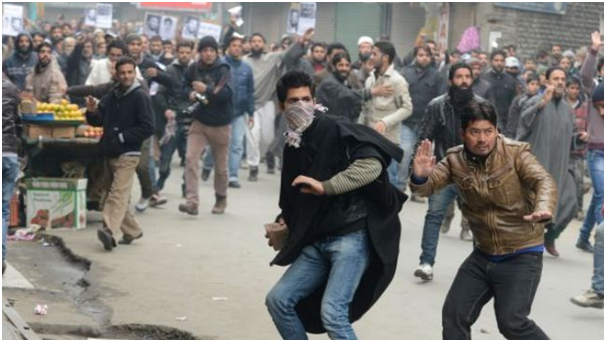Jammu and Kashmir: When Governance Becomes Outright Provocation
A regular scene in Kashmir today
NEW DELHI: Kashmir is moving one crisis to the other, almost as if there is some force in power that wants the Valley to burn. The endless rhetoric by supposedly responsible political leaders, the threats and subsequent action that eats into the rapidly shrinking democratic space of the Kashmiris have led to shut downs, protests, crackdowns as the youth take to the streets to vent their anger over one issue after another.
The recovery of bullet ridden bodies of three young men---Amir Qadir Rishi of Hardshiva, Sopore, Ashiq Hussain Wani of Lolipora, Pattan and Naveed Ahmad Khan of Batapora Sopore---from an apple orchard in Pattan has sparked off a fresh wave of protests. They have been killed recently although Naveen and Ashiq had been reported missing for almost a year, and Amir since July this year.
Efforts to assuage sentiments are non-existent. Governance seems to have turned into provocation with Chief Minister Mufti Mohammad Sayeed unable, or unwilling to step in to take remedial action on a host of issues. The media coverage is certainly not helping with many blaming the Kashmiris as a whole for the disruption of the Kashmir Marathon, when actually it was just a group of motivated youth who used the large support for the event in the Valley to disrupt it. This has been seen any number of times in Delhi and other states where processions are turned violent by just one stone throw, or a rumour that terrifies the participants and turns a peaceful event into a violent incident.
Mufti started the ‘betrayal” as many in the Valley describe it from the word go. The Peoples Democratic Party, that unlike the BJP is indigenous to the Valley and hence should have been far more sensitive to the aspirations of the Kashmiris, started by recognising these in the campaign for the Assembly elections. Promises to address the outstanding issues were made, but the votes really came out to block the fear created by the PDP propaganda that the BJP might win seats in the Valley. This drove non-voters to the polling booths even as Mufti and his candidates insisted that they would not join hands with the BJP.
The voters of Kashmir had no idea that talks were on for precisely such a government formation and the PDP-BJP coalition came to power as soon as the votes, and the seats, were firmly in Mufti’s pocket.
Since then the BJP has revved up its declared agenda in the state. Dilution, abrogation of Article 370; resettlement of Kashmiri pandits in selected conclaves segregated from the rest of the population; change in land laws; beef ban, it has been an endless litany of statements that have created havoc in the insecure Valley. Protests have led to firing that have led to deaths, with statements by supposedly responsible political leaders using the demonstrations to feed further into the ‘terrorist’ canard.
The situation has been made to turn for the worse by the PDP-BJP coalition that has ignored the sensitivities of the conflict impacted state to push through ham handed measures, with the constant rhetoric adding to the volatility of the Valley. The Chief Minister is either silent, or when he or his daughter Mehbooba Mufti speak it is to insist that the issue is not as serious as being made out. For instance when Kashmir reacted to the Jammu and Kashmir High Court beef ban order, all that Mehbooba Mufti could say was “ it is a routine matter.” A statement that did not pacify her own party, let alone the youth.
The floods in Kashmir have added to the long list of incidents of injustice and discrimination. And are really the recent big incident to cast a shadow over the Valley that is palpable in the sullen faces, the visible trauma, and a realisation that the Centre can block even economic help with the state government with little more powers than that of a municipality. Despite some tall promises during the election campaign, the relief and rehabilitation of the flood victims has been negligible. A great deal has been written about this, but to no avail. People are still displaced, those who can afford it are living in rented accommodation, and others have had no alternative but to try and repair the damage but that too, in most cases, only partially.
The Kashmiri youths reading is that if governments cannot even execute ‘economic’ promises of rehabilitation then justice sought in bringing perpetrators of heinous crime to book will never be theirs. This might sound simple, but constitutes yet another landmark for the younger generation, the first being the death of 120 of their colleagues in police firing in 2010. At that time both governments in New Delhi and Srinagar branded all young protestors as ‘terrorists’ leading to alienation and disaffection all through Kashmir. More so as the protestors were just young people, pelting stones at that time for attention to their woes that came , but only in the form of bullets that pushed them further into the corner.
The protests this time carry an air of desperation. And are frequent, with even relatively smaller issues bringing people out onto the streets. Kashmir is simmering with anger, and it is strange that officials and several politicians at the centre talk of a return to violence almost as if they are wishing that to happen. For clearly governments in New Delhi are more comfortable using the military for a straight crack down on the hapless Kashmiris, rather than deal with the sensitivities of a people who are again being pushed to the wall rapidly in a situation that is deteriorating by the day, if not the hour.





